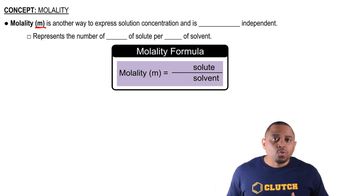Here are the essential concepts you must grasp in order to answer the question correctly.
Boiling Point Elevation
Boiling point elevation is a colligative property that describes how the boiling point of a solvent increases when a solute is dissolved in it. This phenomenon occurs because the presence of solute particles disrupts the solvent's ability to evaporate, requiring a higher temperature to reach the boiling point. The relationship is quantified by the formula ΔT = K_b * m, where ΔT is the change in boiling point, K_b is the molal boiling-point elevation constant, and m is the molality of the solution.
Recommended video:
Molality
Molality (m) is a measure of concentration defined as the number of moles of solute per kilogram of solvent. It is expressed as moles of solute divided by the mass of solvent in kilograms. Unlike molarity, which is affected by temperature changes due to volume expansion, molality remains constant as it is based on mass, making it particularly useful in calculations involving colligative properties like boiling point elevation.
Recommended video:
Normal Boiling Point
The normal boiling point of a substance is the temperature at which its vapor pressure equals the atmospheric pressure (1 atm). For chloroform, this is the boiling point at which it transitions from liquid to gas under standard atmospheric conditions. When a solute is added, the boiling point of the solution increases above this normal boiling point, which is essential for calculating the molal boiling-point elevation constant.
Recommended video:




